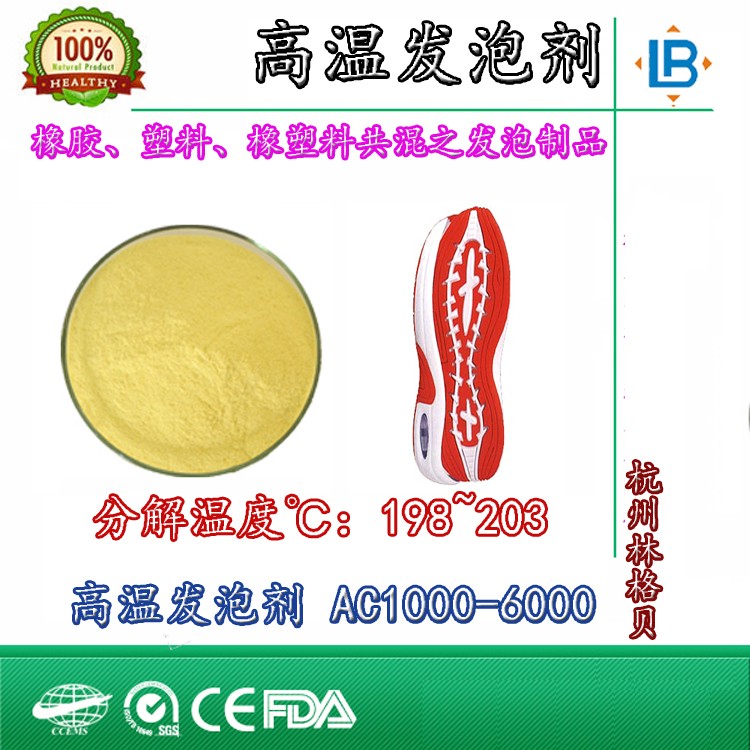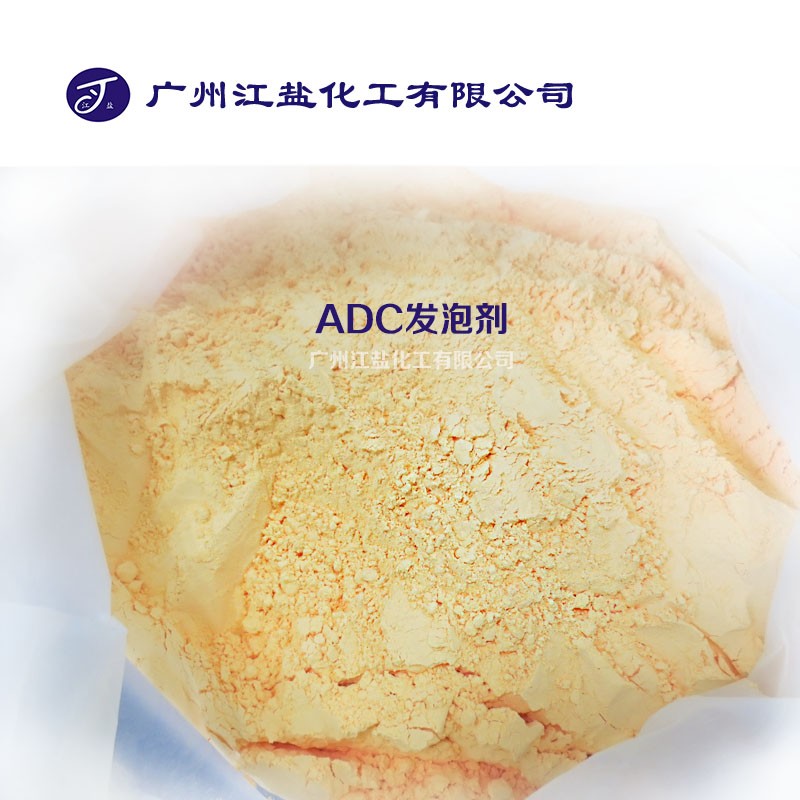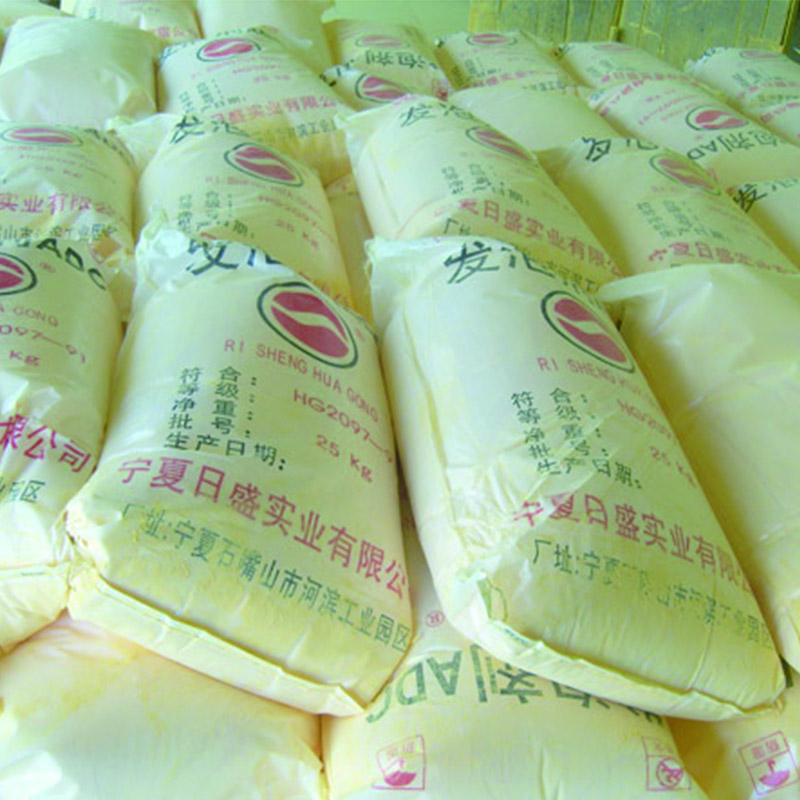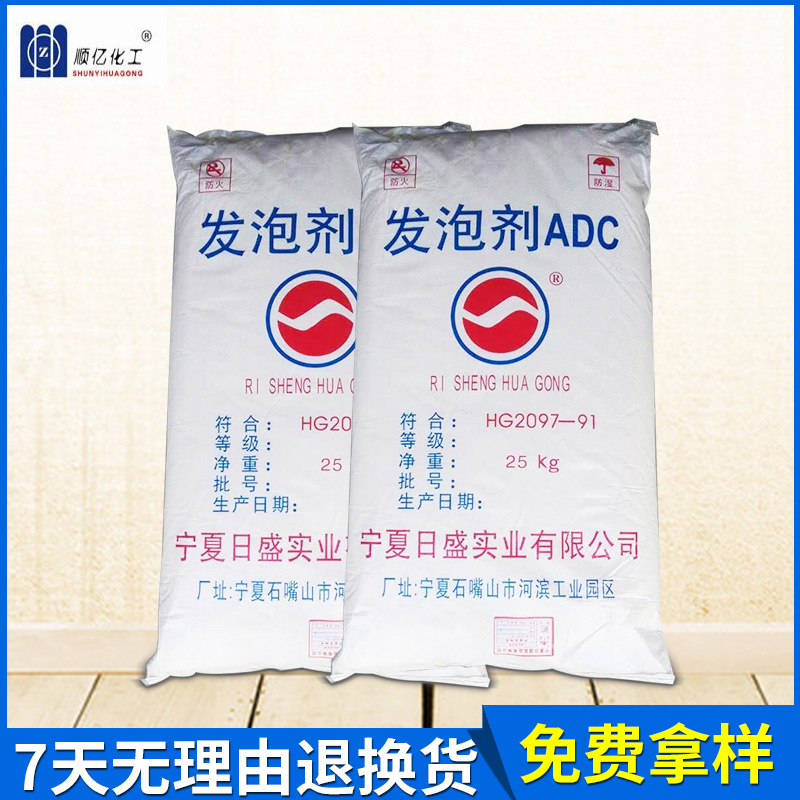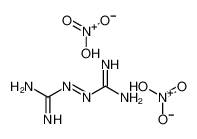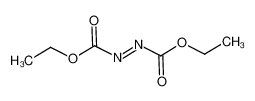| Product name | Azodicarbonamide |
|---|
| Product number | - |
|---|---|
| Other names | Carbamoyliminourea |
| Identified uses | For industry use only. Food Additives: FLOUR_TREATMENT_AGENT |
|---|---|
| Uses advised against | no data available |
| Company | MOLBASE (Shanghai) Biotechnology Co., Ltd. |
|---|---|
| Address | Floor 4 & 5, Building 12, No. 1001 North Qinzhou Road, Xuhui District, Shanghai, China |
| Telephone | +86(21)64956998 |
| Fax | +86(21)54365166 |
| Emergency phone number | +86-400-6021-666 |
|---|---|
| Service hours | Monday to Friday, 9am-5pm (Standard time zone: UTC/GMT +8 hours). |
Respiratory sensitization, Category 1
2.2 GHS label elements, including precautionary statements| Pictogram(s) |  |
|---|---|
| Signal word | Danger |
| Hazard statement(s) | H334 May cause allergy or asthma symptoms or breathing difficulties if inhaled |
| Precautionary statement(s) | |
| Prevention | P261 Avoid breathing dust/fume/gas/mist/vapours/spray. P284 [In case of inadequate ventilation] wear respiratory protection. |
| Response | P304+P340 IF INHALED: Remove person to fresh air and keep comfortable for breathing. P342+P311 If experiencing respiratory symptoms: Call a POISON CENTER/doctor/... |
| Storage | none |
| Disposal | P501 Dispose of contents/container to ... |
none
3.Composition/information on ingredients 3.1 Substances| Chemical name | Common names and synonyms | CAS number | EC number | Concentration |
|---|---|---|---|---|
| Azodicarbonamide | Azodicarbonamide | 123-77-3 | none | 100% |
Consult a physician. Show this safety data sheet to the doctor in attendance.
If inhaledFresh air, rest. Refer for medical attention.
In case of skin contactRemove contaminated clothes. Rinse and then wash skin with water and soap.
In case of eye contactFirst rinse with plenty of water for several minutes (remove contact lenses if easily possible), then refer for medical attention.
If swallowedRinse mouth. Give one or two glasses of water to drink. Rest.
4.2 Most important symptoms/effects, acute and delayedExcerpt from ERG Guide 149 [Substances (Self-Reactive)]: Inhalation or contact with vapors, substance or decomposition products may cause severe injury or death. May produce irritating, toxic and/or corrosive gases. Runoff from fire control may cause pollution. (ERG, 2016)
4.3 Indication of immediate medical attention and special treatment needed, if necessaryAfter inhalation exposure, first aid treatment includes: Fresh air, rest. Refer for medical attention. After skin exposure: Remove contaminated clothes. Rinse and then wash skin with water and soap. After eye exposure: Rinse with plenty of water for several minutes (remove contact lenses if easily possible), then take to a doctor. After ingestion: Rinse mouth. Give plenty of water to drink. Rest. /from table/
5.Fire-fighting measures 5.1 Extinguishing media Suitable extinguishing mediaUse foam or powder. /from table/
5.2 Specific hazards arising from the chemicalExcerpt from ERG Guide 149 [Substances (Self-Reactive)]: Self-decomposition, self-polymerization, or self-ignition may be triggered by heat, chemical reaction, friction or impact. May be ignited by heat, sparks or flames. Some may decompose explosively when heated or involved in a fire. Those substances designated with a (P) may polymerize explosively when heated or involved in a fire. May burn violently. Decomposition or polymerization may be self-accelerating and produce large amounts of gases. Vapors or dust may form explosive mixtures with air. (ERG, 2016)
5.3 Special protective actions for fire-fightersWear self-contained breathing apparatus for firefighting if necessary.
6.Accidental release measures 6.1 Personal precautions, protective equipment and emergency proceduresUse personal protective equipment. Avoid dust formation. Avoid breathing vapours, mist or gas. Ensure adequate ventilation. Evacuate personnel to safe areas. Avoid breathing dust. For personal protection see section 8.
6.2 Environmental precautionsPersonal protection: particulate filter respirator adapted to the airborne concentration of the substance. Sweep spilled substance into covered sealable containers. If appropriate, moisten first to prevent dusting. Carefully collect remainder. Then store and dispose of according to local regulations.
6.3 Methods and materials for containment and cleaning upSweep spilled substance into sealable containers; if appropriate, moisten first to prevent dusting. Carefully collect remainder, then remove to safe place.
7.Handling and storage 7.1 Precautions for safe handlingAvoid contact with skin and eyes. Avoid formation of dust and aerosols. Avoid exposure - obtain special instructions before use.Provide appropriate exhaust ventilation at places where dust is formed. For precautions see section 2.2.
7.2 Conditions for safe storage, including any incompatibilitiesStore in cool place. Keep container tightly closed in a dry and well-ventilated place.
8.Exposure controls/personal protection 8.1 Control parameters Occupational Exposure limit valuesno data available
Biological limit valuesno data available
8.2 Appropriate engineering controlsHandle in accordance with good industrial hygiene and safety practice. Wash hands before breaks and at the end of workday.
8.3 Individual protection measures, such as personal protective equipment (PPE) Eye/face protectionSafety glasses with side-shields conforming to EN166. Use equipment for eye protection tested and approved under appropriate government standards such as NIOSH (US) or EN 166(EU).
Skin protectionWear impervious clothing. The type of protective equipment must be selected according to the concentration and amount of the dangerous substance at the specific workplace. Handle with gloves. Gloves must be inspected prior to use. Use proper glove removal technique(without touching glove's outer surface) to avoid skin contact with this product. Dispose of contaminated gloves after use in accordance with applicable laws and good laboratory practices. Wash and dry hands. The selected protective gloves have to satisfy the specifications of EU Directive 89/686/EEC and the standard EN 374 derived from it.
Respiratory protectionWear dust mask when handling large quantities.
Thermal hazardsno data available
9.Physical and chemical properties| Physical state | orange crystalline powder |
|---|---|
| Colour | Orange-red crystals |
| Odour | no data available |
| Melting point/ freezing point | 220-225ºC (dec.) |
| Boiling point or initial boiling point and boiling range | 284.8ºC at 760mmHg |
| Flammability | Flammable. Gives off irritating or toxic fumes (or gases) in a fire. |
| Lower and upper explosion limit / flammability limit | no data available |
| Flash point | 126ºC |
| Auto-ignition temperature | no data available |
| Decomposition temperature | 225°C |
| pH | no data available |
| Kinematic viscosity | no data available |
| Solubility | In water:SOLUBLE IN HOT WATER |
| Partition coefficient n-octanol/water (log value) | log Kow = -1.7 |
| Vapour pressure | 7.1 mm Hg at 19°C ; 10.7 mm Hg at 26.5°C |
| Density and/or relative density | 1.65 |
| Relative vapour density | no data available |
| Particle characteristics | no data available |
no data available
10.2 Chemical stabilityDoes not react with plasticizers and other components of plastics.
10.3 Possibility of hazardous reactionsFlammableAZODICARBONAMIDE is easily ignited and burns rapidly. Confined samples show a high rate of pressure rise during thermal decomposition, which produces carbon monoxide and nitrogen. Sensitive to temperatures exceeding 50°C. May be sensitive to exposure to light. Stable in bulk when stored for two weeks at temperatures up to 60°C. Slightly unstable in water suspension (showed 1.3% decomposition at 2 mg/mL over a two-week period at room temperature in the light but no decomposition at 5°C over a two-week period in the dark . Reacts with hot water to give nitrogen, carbon monoxide, and ammonia [Hawley]. Decomposes in hot hydrochloric acid. Incompatible with strong acids and bases, and with compounds of metals.
10.4 Conditions to avoidno data available
10.5 Incompatible materialsno data available
10.6 Hazardous decomposition productsWhen heated to decomposition it emits toxic fumes of /nitrogen oxides/.
11.Toxicological information Acute toxicity- Oral: no data available
- Inhalation: LC50 Rat inhalation >6100 mg/cu m/4 hr (dry aerosol; median mass aerodynamic diameter 5.8+/- 2.25 um [geometric standard deviation])
- Dermal: no data available
no data available
Serious eye damage/irritationno data available
Respiratory or skin sensitizationno data available
Germ cell mutagenicityno data available
Carcinogenicityno data available
Reproductive toxicityno data available
STOT-single exposureno data available
STOT-repeated exposureno data available
Aspiration hazardno data available
12.Ecological information 12.1 Toxicity- Toxicity to fish: no data available
- Toxicity to daphnia and other aquatic invertebrates: no data available
- Toxicity to algae: no data available
- Toxicity to microorganisms: no data available
no data available
12.3 Bioaccumulative potentialAn estimated BCF of 3 was calculated for 1,1'-azo-bis(formamide)(SRC), using a log Kow of -1.7(1) and a regression-derived equation(2). According to a classification scheme(3), this BCF suggests the potential for bioconcentration in aquatic organisms is low(SRC).
12.4 Mobility in soilThe Koc of 1,1'-azo-bis(formamide) is estimated as 3(SRC), using a log Kow of -1.7(1) and a regression-derived equation(2). According to a classification scheme(3), this estimated Koc value suggests that 1,1'-azo-bis(formamide) is expected to have very high mobility in soil(SRC).
12.5 Other adverse effectsno data available
13.Disposal considerations 13.1 Disposal methods ProductThe material can be disposed of by removal to a licensed chemical destruction plant or by controlled incineration with flue gas scrubbing. Do not contaminate water, foodstuffs, feed or seed by storage or disposal. Do not discharge to sewer systems.
Contaminated packagingContainers can be triply rinsed (or equivalent) and offered for recycling or reconditioning. Alternatively, the packaging can be punctured to make it unusable for other purposes and then be disposed of in a sanitary landfill. Controlled incineration with flue gas scrubbing is possible for combustible packaging materials.
14.Transport information 14.1 UN Number| ADR/RID: UN3242 | IMDG: UN3242 | IATA: UN3242 |
| ADR/RID: AZODICARBONAMIDE |
| IMDG: AZODICARBONAMIDE |
| IATA: AZODICARBONAMIDE |
| ADR/RID: 4.1 | IMDG: 4.1 | IATA: 4.1 |
| ADR/RID: II | IMDG: II | IATA: II |
| ADR/RID: no | IMDG: no | IATA: no |
no data available
14.7 Transport in bulk according to Annex II of MARPOL 73/78 and the IBC Codeno data available
15.Regulatory information 15.1 Safety, health and environmental regulations specific for the product in question| Chemical name | Common names and synonyms | CAS number | EC number |
|---|---|---|---|
| Azodicarbonamide | Azodicarbonamide | 123-77-3 | none |
| European Inventory of Existing Commercial Chemical Substances (EINECS) | Listed. | ||
| EC Inventory | Listed. | ||
| United States Toxic Substances Control Act (TSCA) Inventory | Listed. | ||
| China Catalog of Hazardous chemicals 2015 | Listed. | ||
| New Zealand Inventory of Chemicals (NZIoC) | Listed. | ||
| Philippines Inventory of Chemicals and Chemical Substances (PICCS) | Listed. | ||
| Vietnam National Chemical Inventory | Listed. | ||
| Chinese Chemical Inventory of Existing Chemical Substances (China IECSC) | Listed. | ||
| Creation Date | Aug 12, 2017 |
|---|---|
| Revision Date | Aug 12, 2017 |
- CAS: Chemical Abstracts Service
- ADR: European Agreement concerning the International Carriage of Dangerous Goods by Road
- RID: Regulation concerning the International Carriage of Dangerous Goods by Rail
- IMDG: International Maritime Dangerous Goods
- IATA: International Air Transportation Association
- TWA: Time Weighted Average
- STEL: Short term exposure limit
- LC50: Lethal Concentration 50%
- LD50: Lethal Dose 50%
- EC50: Effective Concentration 50%
- IPCS - The International Chemical Safety Cards (ICSC), website: http://www.ilo.org/dyn/icsc/showcard.home
- HSDB - Hazardous Substances Data Bank, website: https://toxnet.nlm.nih.gov/newtoxnet/hsdb.htm
- IARC - International Agency for Research on Cancer, website: http://www.iarc.fr/
- eChemPortal - The Global Portal to Information on Chemical Substances by OECD, website: http://www.echemportal.org/echemportal/index?pageID=0&request_locale=en
- CAMEO Chemicals, website: http://cameochemicals.noaa.gov/search/simple
- ChemIDplus, website: http://chem.sis.nlm.nih.gov/chemidplus/chemidlite.jsp
- ERG - Emergency Response Guidebook by U.S. Department of Transportation, website: http://www.phmsa.dot.gov/hazmat/library/erg
- Germany GESTIS-database on hazard substance, website: http://www.dguv.de/ifa/gestis/gestis-stoffdatenbank/index-2.jsp
- ECHA - European Chemicals Agency, website: https://echa.europa.eu/






